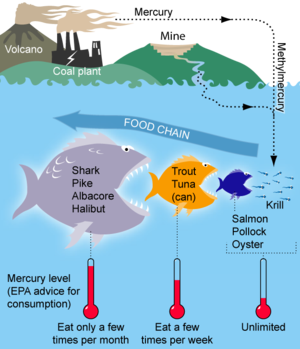When you're shopping for tuna, have you been sucked into thinking that Albacore is the only way to go? You're not really sure of the reason, but it's definitely the can you pick up, because it sounds like the superior choice?
I made that mistake many years ago, until I became informed on the topic. It's important to be aware of mercury exposure, and admittedly, I'm on the fence. While I'm currently a Vegan Flirt (assessing what diet is best for me), at this time I believe the benefits of certain fish in my diet outweigh the risks. Fish is a lean, low-calorie source of protein replete with omega 3 fatty acids and vitamin B12 (as essential vitamin only found in fish, shellfish, meat, dairy and eggs). But some varieties of fish do cause me concern, and for good reason...
How does mercury get into our food?
Mercury is a naturally occurring element in the environment. It can also be released into the air through industrial pollution. Mercury falls from the air and into lakes, streams and oceans, whereby it converts to methylmercury. It is this form of mercury that can be harmful to unborn babies and young children. Fish absorb environmental methylmercury as they feed, and thus it accumulates in their tissues. However, this accumulation varies - some types of fish and shellfish are more susceptible depending on what they prey on, and the levels of methylmercury is variable in different environments.
In general, larger species of fish (such as shark) that are long-lived and prey on larger varieties of fish tend to accumulate more mercury in their tissues, since they are on the top end of the food chain. Shrimp are on the bottom of the food chain - they are smaller and feed on phytoplankton and zooplankton, and accumulate less methylmercury than their larger predators. The figure below illustrates this point beautifully.

The most common way people in the US are exposed to mercury is by eating fish containing methylmercury. Some fish may contain methylmercury at levels that may be a cause of concern. Note that most people's blood mercury level is below the level associated with possible health effects (<5.8 µg/L of whole blood), and that considerations around mercury intake primarily affect the following groups:
- women who might become pregnant
- women who are pregnant
- nursing mothers
- young children
So - How to choose fish and canned tuna?
Avoid:
- canned Albacore (also called white tuna in the US and Canada)
- Albacore is a large variety of tuna and tends to accumulate higher levels of mercury than other tuna varieties
- Beware of "chunk white" or "solid white" labels
- Shark, Swordfish, King Mackerel, Tilefish, Marlin, Bluefin tuna
- these are all large species of fish at the top of the food chain
- canned Light Tuna
- most people mistake the "light" to mean "less caloric", "less dense", "less fatty", etc. Light Tuna is primarily composed of a smaller species of tuna called Skipjack, but can include others such as Bigeye, Yellowfin, and Tongol, in “any combination". These varieties are lower in mercury levels than Albacore and Bluefun as they are smaller and accumulate less mercury. However, Yellowfin has come under fire as sometimes having higher levels of methylmercury than Skipjack - and there are no regulations on combination ratios.
- shrimp, pollock, salmon, catfish, oysters, trout, anchovies, tilapia, haddock, lobster, crab, hake, butterfish
- check out this table for mercury levels**
What's the take-away?
- If concerned about mercury levels, do not eat Shark, Swordfish, Pike, King Mackerel, Marlin, Tilefish.
- Eat no more than 12 ounces (two average meals) a week of a variety of fish and shellfish that are lower in mercury.
- You can consider eating up to 6 ounces of Albacore tuna per week.
- Your body will excrete methylmercury, but the clearance is slow, with overall half-life (i.e. the time to excrete half of ingested amount) at 70-80 days. This varies by tissue (and the numbers are sobering). The body is exceptionally efficient at excreting mercury in lactating females.
- I watched a documentary once about the canned tuna industry in the US - they catch the tuna, gut and often cook it right on board (often twice) to rid the tuna of its "fishy" flavor and smell. However, in this process, the omega 3's are removed and dumped into the ocean as the fish is cooked en route to land. So if you're looking for some omega 3, the Pacific Northwest has a bunch floating around in it! Also note that because of this process, canned tuna has variable amounts of omega 3, which is not consistent from can to can.
- Check local advisories about the safety of fish caught by family and friends in your local lakes, rivers, and coastal areas. If no advice is available, eat up to 6 ounces (one average meal) per week of fish you catch from local waters, but don't consume any other fish during that week.
Click here for EPA guidelines on mercury exposure.
Please see:
EPA-FDA Joint Federal Advisory for Mercury in Fish: “What You Need to Know About Mercury in Fish and Shellfish”:

No comments:
Post a Comment